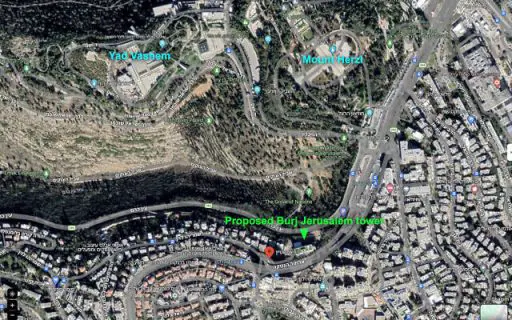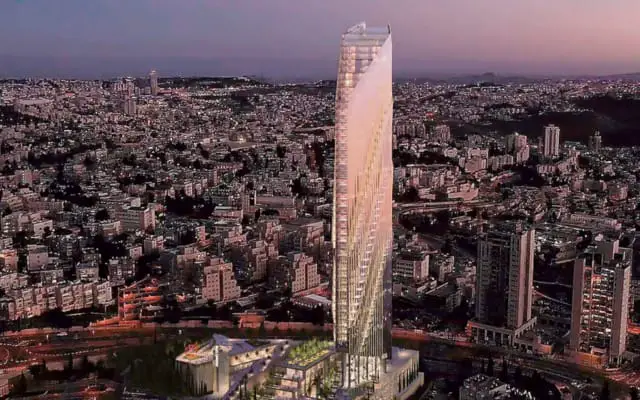Jerusalem’s cityscape may soon undergo a significant transformation with the proposed construction of a 200-metre-high tower in the western part of the city. If realised, this tower would become not only the tallest building in the capital but also an architectural landmark. It was designed by a US-based architecture firm, Adrian Smith and Gordon Gill Architecture.
One of the partners, Adrian Smith, previously led the team that designed the Burj Khalifa in Dubai, the world’s tallest building. Jerusalem Municipality praises this initiative as groundbreaking. The project’s unique architectural design suits its prominent location.
Location for the 200-metre-high tower in Jerusalem
The proposed structure is planned for the Epstein compound, close to Caldwell’s renowned sculpture, “Homage to Jerusalem”. Designers envision a tower containing around 240 homes plus a spacious 9,000-square-meter hotel. Additionally, the plans comprise ample public spaces: an outdoor plaza and subterranean facilities.

The project is very important, and it is more than just a fantastic building. It will be on a rail line. This follows city rules about having more people live near transit. The project shows how cities plan to grow and change as more people keep coming and the governments want cities to grow.
The tower has public space and maybe a place to look out. The city chose it over two shorter towers. This shows the city wants to make public places better. It wants to make better views.
READ ALSO: Construction Completes on Japan’s Tallest Skyscraper, Mori JP Tower
Oppositions for the 200-metre-high tower
The project aroused debate, facing opposition from roughly 200 organisations and individuals. They worried about its effects on nearby landmarks and the local community’s well-being. Critics, headed by Deputy Mayor Yossi Havilio, argued the tower’s imposing presence would overshadow vital sites. Examples are the Yad Vashem Holocaust Remembrance Center and the IDF cemetery on Mount Herzl. They believed this would lessen the sanctity and beauty of these areas. Moreover, Havilio contended the project, targeting wealthy buyers, neglected addressing Jerusalem residents’ broader housing needs.
The Architects Association’s Rivka Gutman criticises Jerusalem’s planning approach without an approved master plan. They argue that this results in irregular projects harming the city’s character and quality of life. Still, opposition arises from groups representing fallen soldiers’ families, like Yad Labanim, who believe the tower’s proximity to the cemetery where their loved ones rest disrespects sensibilities, particularly in Israel’s challenging periods.
Despite these challenges, the local Jerusalem planning committee has moved forward with the proposal. The plan will go to the district committee after public objections. The debate highlights the tricky balance in Jerusalem – between city growth, preserving history, and community values. The city is known for its unique cultural and spiritual importance.
Which is the tallest building in Jerusalem?
As of March 2024, the current tallest building in Jerusalem is Holyland Tower 1, with a height of 121 meters. The 200-metre under-construction tower, designed by the firm led by Adrian Smith, completes, it would become the highest in the capital.

